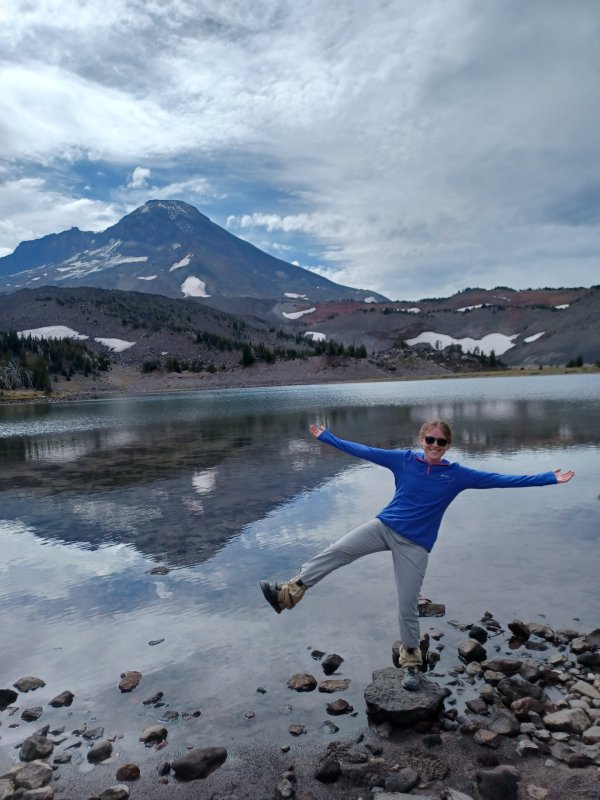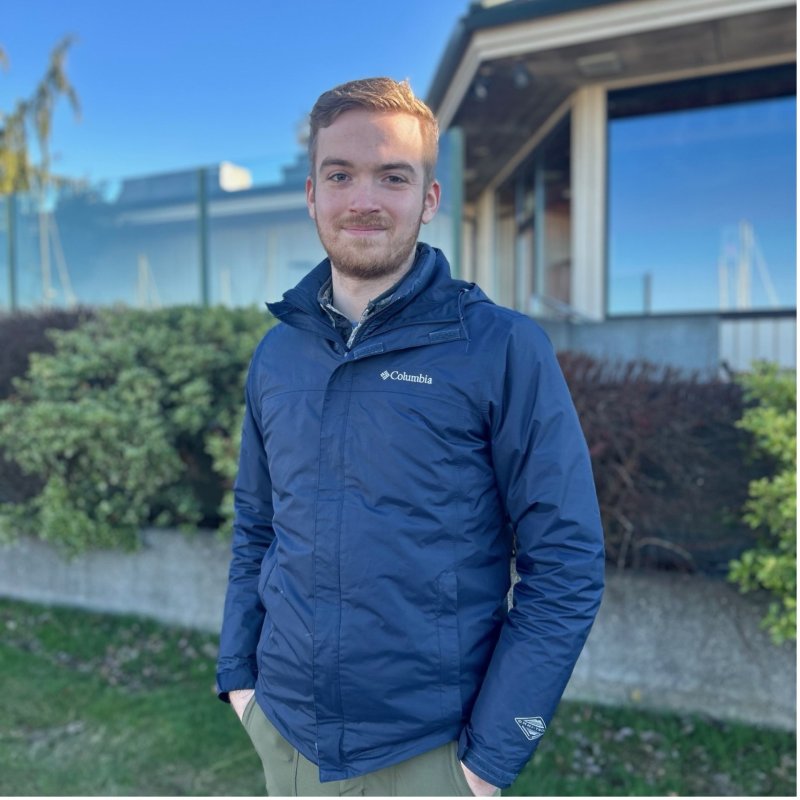Grad students uncovering the mysteries of Oregon's Three Sisters Range, genetic variation in aging
Western’s faculty and students are engaged in exciting research and scholarship across a variety of fields. Periodically, Western Today will share short summaries of the latest developments in scholarly work at the University. Want to read more stories about research at Western? Go the WWU News Archive and select "Research" under the Categories menu.
Madelyn Cook, Geology
At Western, Madelyn Cook (she/her) is uncovering the secrets lurking in the magma systems beneath the Three Sisters volcanoes.
Cook is a graduate student of geology at Western. Along with her research group, which consists of both graduate and undergraduate students, Cook is studying the Three Sisters Volcanic Complex in Central Oregon. More specifically, Cook’s research focuses on the rhyolite of Separation Creek. She’s looking at the magmatic components of the rhyolite, which is a silica-rich volcanic rock that contains mafic (low-silica) enclaves, as a way of understanding the magma reservoirs, which cannot be studied directly. Cook says the objective of her research is to “figure out how those [mafic] enclaves got there, where they may have come from, and if that could suggest interaction between the Three Sisters and their magma systems.” Looking at the mineral compositions of the rhyolite of Separation Creek might also indicate what temperature, pressure, and magmatic composition conditions the minerals crystalized in, and what caused the eruption.
Studying this eruption doesn’t just help us understand what happened in the past. According to Cook, one reason for studying the rhyolite of Separation Creek is because of an ongoing inflation five kilometers west of South Sister. “If there is an eruption, it would likely be a rhyolite one. So studying the rhyolite of Separation Creek can help us understand what the system has done in the past and have an idea of what it could do again in the future.”
Last fall, Cook was the recipient of Western’s Research and Creative Opportunities grant. Through this award, Cook travelled to Oregon State University and conducted analysis work using their microprobe on samples from Separation Creek. This process allowed Cook to identify the major and minor element composition of the rocks, which she says is “the big main first step you have to do before you can do everything else.” In December, Cook attended a conference for the American Geophysical Union, where she presented a poster on her research alongside other members of her group.
While Cook is still in the middle of her research, and there is much still to uncover about the magma systems of the Three Sisters Volcanic Complex, there are many exciting theories that she is working through. The rhyolite, which erupted in the saddle between Middle Sister and South Sister, is associated with South Sister. Cook, however, has found that “the olivine in the enclaves compositionally matches up with pretty much exactly the basaltic andesites of Middle Sister, which means the magma system feeding Middle Sister and South Sister are touching and mixing in the middle.” To further investigate this possibility—that Middle Sister and South Sister share a magma system—Cook plans to research the composition of trace elements to determine whether this is the case or if the systems are distinct from one another.
On working with her advisor, Geology faculty member Mai Sas, Cook says “I really appreciate my advisor, she’s been very helpful; she works so hard and supports us. She encourages us to make the most out of any opportunity and helps us get as much experience as possible—in the field and on instruments.” Cook said both her advisor and the group’s United States Geological Survey contact, Nathan Andersen, both care strongly about the field of volcanology and their project on the Three Sisters volcanoes.
During her free time as a graduate student in Bellingham, Cook enjoys running and hiking the trails around town and in the mountains. Cook says that one of her favorite things about studying at Western is all the opportunities available to students. In particular, she mentions that having access to equipment like the Laser Ablation Inductively Coupled Plasma Mass Spectrometer (LA-ICP-MS) and a Scanning Electron Microscope is rare for university students, but students at Western are encouraged to use them.
Aidan Corbin, Biology
To tackle the big questions on aging, Aidan Corbin is starting small.
Aidan Corbin (he/him) is a first-year biology graduate student at Western. Corbin began working in the Pollard Lab as an undergraduate while majoring in neuroscience and psychology. Now, as a graduate student, Corbin is continuing his research with WWU Associate Professor of Biology Dan Pollard.
Corbin’s project focuses on natural genetic variation in aging. According to Corbin, yeast is a great model organism for gene research because it’s inexpensive, easy to get a lot of, and the genome for yeast is very well conserved. As part of his research project, Corbin is examining why some yeast lives longer than other yeast and the genetic cause of that variability.
When yeast reproduces, it undergoes a process called asymmetric cell division, where there is a mother cell and a daughter cell that buds off from the mother. As Corbin describes, “Each time the daughter cell buds off, the mother cell is left with scars where the daughter cell left. And so, it provides a metric for age because we can look at those scars and count them with a microscope.” Corbin is investigating what happens as the cells age and trying to identify connections between aberrant gene expression and variation in the lifespan of the yeast.
This fall, Corbin won a Research and Creative Opportunities Grant from Western. Corbin is using this funding to purchase essential equipment for his research like Miniature Aging Devices (MADs). Because of the way yeast cells reproduce, Corbin says that collecting just the old mother yeast is like finding a needle in a haystack. To collect the old yeast cells, Corbin uses MADs. This device traps the old yeast cells by attaching magnets to them. This way, when the cells reproduce, the daughter cells will not have the magnet in them and be swept away, but the mother cells will remain stuck in the chamber.
According to Corbin, aging is one of the most significant risk factors for many prevalent human diseases, so understanding what is happening within the genes themselves is the first step to understanding why we age and how to prevent diseases like Alzheimer's and cardiovascular diseases.
As part of the Pollard Lab, Corbin works with a research team, which for the past year has included undergraduate Karlee Cowlishaw.
“I think research happens in teams. It’s always a lot of team effort, and it’s a great feeling to be able to bounce ideas off each other and talk things out. A lot of conversations start with the two of us being confused about something. We bounce ideas off each other, and then we go talk to Dan [Pollard]. It feels like you are contributing to science,” Corbin says. For this project, Corbin has also been collaborating with researchers at the University of Washington Donham Lab, who are helping pilot the experiment.
One of Corbin’s favorite parts of being a graduate student at Western is faculty’s commitment to mentorship.
“Being a graduate student at Western is really phenomenal because of the mentorship that you get — that I get working with Dan. Your relationship with your instructor or PI (principal investigator) is a lot closer than it would be at a bigger university. I feel a lot more connected to the lab than I would at a much bigger lab,” Corbin said.

